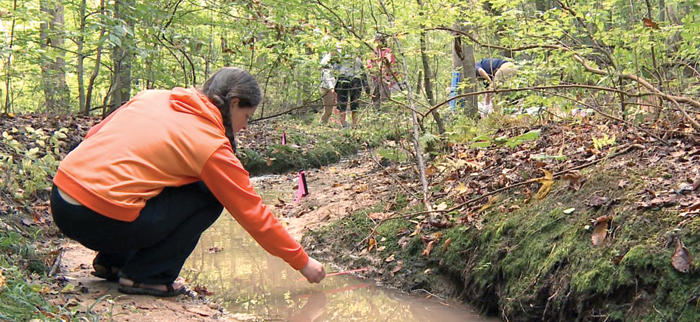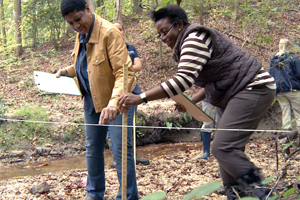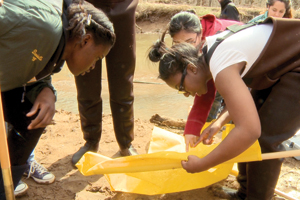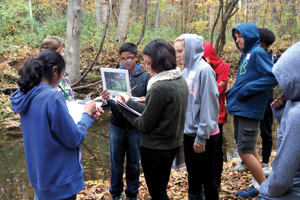Through an Educator’s Eyes: Explore and Restore Maryland Streams

Investigating microhabitats; department photo
Modeling practices used by Department of Natural Resources scientists, adventurous teachers and their inspired students have been heading out of the classroom to monitor streams across the state. Their mission: to determine the health and conditions of waterways near their schools.
Conducted through the Explore and Restore Maryland Streams program, department biologists host one-day professional development workshops on a range of topics: stream ecology, how land use influences streams and which animals call these ecosystems home. They prepare teachers to facilitate biological, chemical and physical assessments, allowing them to grow their content knowledge as well as their confidence working in outdoor environments.
| Explore and Restore started in 2012 as a partnership between environmental educators and scientists to connect students with streams. The collaboration led to the development of a workshop and accompanying resources that show teachers how to use streams as a living laboratory. The program is expanding through funding provided to partners to work with additional schools statewide.
Since its onset, the program has reached more than 150 schools and 283 teachers in 22 counties and Baltimore City. Educators at 77 schools are slated to receive training throughout the 2015-2016 academic year, with a reach of more than 12,000 students. |
A teacher’s tale
Suzanne Hughes—a recent workshop participant—from Reservoir High School in Howard County raves over the Explore and Restore Maryland Streams program.
“It’s always nice to attend meetings for professional development and actually get out and do something meaningful that the students are going to use and find helpful,” Hughes says.

Teachers learn how to measure and monitor storm impact; department photo
The program uses the diversity of life within a stream—fish, salamanders, macro invertebrates—as an indication of its health. Students use current scientific practices to arrive at a conclusive water quality assessment, and ultimately use their findings to take appropriate action to improve the stream’s health.
Hughes and others in the workshop found they didn’t need a lot of high tech equipment or resources to incorporate most of the activities into the classroom or lead students through investigations of nearby streams.
“Through Explore and Restore, the students gain a deeper appreciation for their surroundings,” Hughes says. “When you get them to turn off the TV and go outside without their phones for a couple of hours, it makes a huge difference in how they see everything around them.”
Taking the classroom outside
Hughes found that through these outdoor experiences her students got a chance to engage and connect with concepts discussed in the classroom. After students investigate and analyze their data, they are asked to propose and implement an action plan to improve the conditions: perhaps building a rain garden or developing a plan for community outreach.

Students gather and collect data; department photo
“You can do a lab, but it doesn’t really connect with anything beyond the classroom,” Hughes says. “This experience links everything together for the kids—they aren’t looking at disjointed pieces. It’s wonderful to see everything fall into place for them.”
An added bonus for teachers, students love the experience and exposure to nature. Even if they aren’t excited in the beginning of the project, they eventually get keyed up.
“I’ve had students say ‘I’m not touching any bugs!’ and yet, they can’t not do it,” Hughes says. “They’re wading in the water, even in cold water. They’re picking up leaves and rocks, trying to find something…trying to find more than the next person. I’ve had kids look around introspectively and say ‘Jeez, it’s really beautiful out here,’ as if they just had never thought about it before.”

Students gather and collect data; department photo
Empowering students
In the wake of such a practical lesson, students take away a new appreciation for how important it is to tread lightly in the environment—to be more conscious of what they put down a storm drain, to think about where trash ends up, to recycle.
“The biggest takeaway for students that I can see is an understanding that what they do has an impact on a lot of other things,” Hughes says. “When they throw trash on the ground, for example, it’s not just a stand-alone event when everybody else does the same thing. They get a better grasp for the impact of many actions that might occur on a daily basis and they start to realize change can start with them.”
Hughes has even given other teachers within her school some tools to use with their students to introduce some program concepts. Her fellow educators have introduced their own students to water monitoring, reinforcing how the health of the stream impacts the fate of the Chesapeake Bay and, equally, how everyone effects the environment.
“I would recommend this program to any teacher,” Hughes concludes. “I plan to use my training for years to come and I’m confident that it will continue to have a big impact on my students: the future of Maryland.”
Article by Amanda Sullivan—Chesapeake & Coastal Service streams education coordinator.
Appears in Vol. 19, No. 1 of the Maryland Natural Resource magazine, winter 2016.


 1-888-373-7888
1-888-373-7888 233733
233733